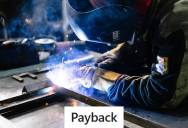Swiss Chemical Engineers Find A Way To Recycle Plastic Without Deterioration

How much plastic waste do you generate?
In a 2022 report, Greenpeace estimated that the US generates 51 million tons of plastic waste every year, amounting to about 309 pounds of plastic per person.
But you recycle that, right?
Unfortunately, according to the report, despite your best efforts, only about 5% of plastic waste is recycled.
Due to many factors, including overpromising and capacity issues, to technological inabilities to recycle some types of plastic, around 95% of plastic waste in the US ends up in landfill.
This is a problem.
With plastic made of oil, a fossil fuel, the creation of plastic is a huge contributory factor to the climate crisis. Plastic that isn’t properly recycled and goes to landfill doesn’t break down easily; instead it chokes wildlife, contaminates soil and ruins ecosystems.
If it ends up blowing into the ocean, it damages our vital marine ecosystems too. When it does eventually break down, microplastics end up killing animals and even causing adverse health effects inside our bodies too.
To remedy this global problem, scientists around the world are committed to finding efficient and reliable ways to recycle plastics.
Traditional plastic recycling involves the plastic being shredded, melted and reformed into new products.
While successful, this results in deteriorating quality, as the plastic gets worse with each stage of the recycling process.

Scientists at ETH Zurich, Switzerland, have a solution. In a recent paper, published in Nature Chemical Engineering, a research team led by Javier Pérez-Ramírez, Professor of Catalysis Engineering explain a pioneering future for plastic recycling.
Using processes of chemical recycling, the scientists have seen the opportunity to use our existing plastic to create some of the fossil fuel products that the world is currently struggling to avoid using, as the researchers explain in the statement:
“Chemical recycling involves breaking down long-chain plastic molecules (polymers) into their fundamental building blocks (monomers), which can be reassembled into new, high-quality plastics, creating a truly sustainable cycle.
As the approach of chemical recycling develops, the initial focus is on breaking down these long polymer chains into shorter-chain molecules that can be used as liquid fuels, say, or lubricants. This gives plastic waste a second life as petrol, jet fuel or engine oil.”
In their developments of the chemical recycling process, the researchers broke down two stubborn types of plastic, polyethylene and polypropylene.
The first step is to contain the plastic in a steel tank. Unlike the plastic, the steel tank won’t melt when the plastic does. Hydrogen gas is added to the tank, as well as a metal containing powder to act as a catalyst.
Scientists used ruthenium in this project, because they deemed it to be the most efficient at helping to break down the plastic in a way that would form the desired molecules.
The specific compounds of ruthenium, when added to form this reaction, wouldn’t release methane or propane, thus avoiding releasing other undesirable byproducts into the atmosphere.
What was the result?
A super thick molten plastic. But it takes some additional work to get there, as explained by co-author Antonio José Martín:
“The molten plastic is a thousand times thicker than honey. The key is how you stir it in the tank to ensure the catalyst powder and hydrogen get mixed right through.”
The researchers had to determine exactly what shape and speed of blade the plastic should be stirred with to make the process effective. In the statement, the researchers explained the simulations and tests that helped them reach the ultimate design:
“The plastic is best stirred using an impeller with blades parallel to the axis. Compared to a propeller with angled blades or a turbine-shaped stirrer, this results in more even mixing and fewer flow vortices. The stirring speed is equally crucial. It must be neither too slow nor too fast; the ideal speed is close to 1,000 revolutions per minute.”

Having now published their successful research project, including a mathematical formula that allows their chemical recycling process to be replicated, the researchers hope that more consistent and effective plastic recycling is not too far off in our planet’s future.
For now, keep recycling: and there’s hope that your waste plastic may be broken down like this very soon.
If you thought that was interesting, you might like to read a story that reveals Earth’s priciest precious metal isn’t gold or platinum and costs over $10,000 an ounce!

Sign up to get our BEST stories of the week straight to your inbox.




